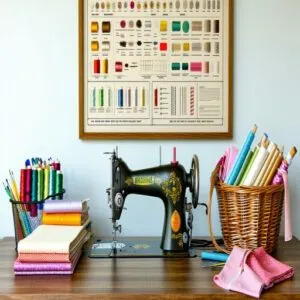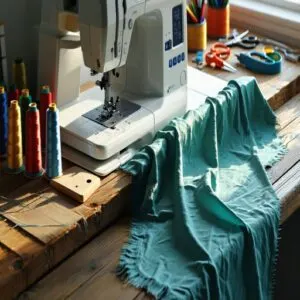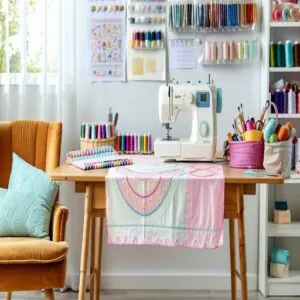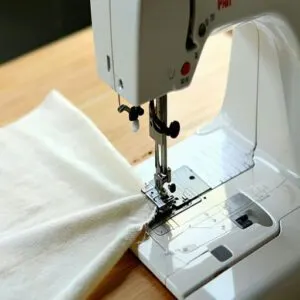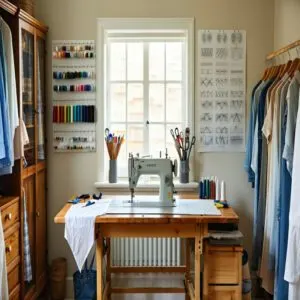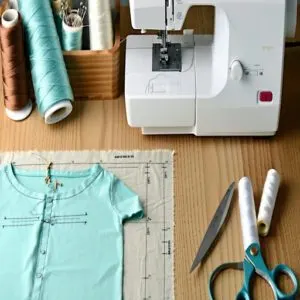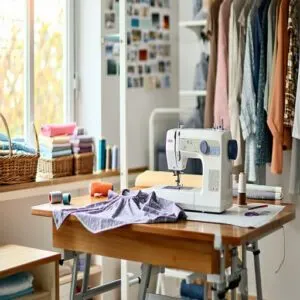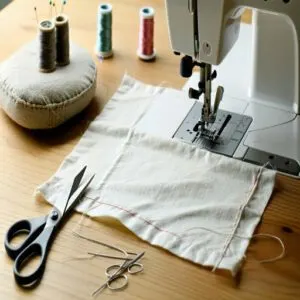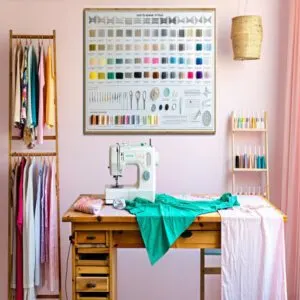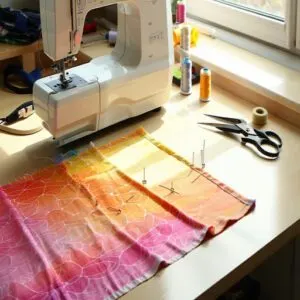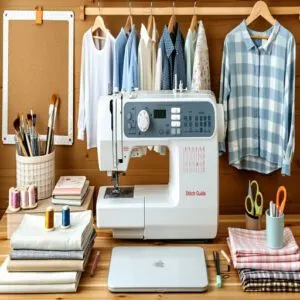This site is supported by our readers. We may earn a commission, at no cost to you, if you purchase through links.
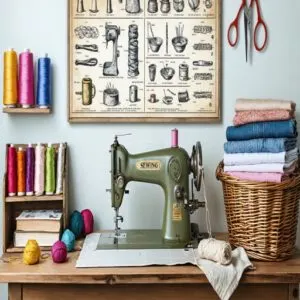 Choosing the right stitch can make or break your sewing project—literally.
Choosing the right stitch can make or break your sewing project—literally.
For basic seams or topstitching, stick to the trusty straight stitch.
Need stretchy seams? Zigzag or stretch stitches are your best friends.
Want invisible hems? The blind hem stitch works like magic.
For hand sewing, backstitch adds strength, while running stitches are perfect for quick fixes.
Don’t forget fabric type—delicate silks need gentle stitching, while denim demands durability.
And always match your thread and needle to your fabric.
Think of stitches as tools in your sewing toolbox—pick the right one, and your project will hold up beautifully (and impressively).
Table Of Contents
Key Takeaways
- Match the stitch type to your fabric and project needs—straight stitch for seams, zigzag for stretchy fabrics, and blind hem for invisible finishes.
- Always test your stitches on fabric scraps first to check for tension, compatibility, and appearance.
- Use proper needles and threads for your fabric; for instance, ballpoint needles work for knits and sharp needles for woven fabrics.
- Adjust thread tension, stitch length, and speed as necessary to prevent puckering, skipped stitches, or uneven seams.
Sewing Stitch Basics
Mastering the basics of sewing stitches sets the foundation for every project you’ll tackle.
From the reliable straight stitch to the versatile zigzag, understanding their uses will make your sewing smoother—and maybe even a little fun!
Straight Stitch Uses
The straight stitch is your go-to for fabric seam construction and more.
It’s simple, versatile, and essential for any sewing guide.
Master these uses:
- Seaming: Perfect for joining fabric pieces.
- Topstitching: Adds a polished look.
- Basting: Temporary holds before final stitching.
- Hemming: Clean, durable edges.
- Reinforcing: Strengthens seams with reverse stitching.
Control thread tension, adjust stitch length, and optimize sewing speed for flawless results.
Zigzag Stitch Applications
The zigzag stitch is your go-to for versatility.
It’s perfect for zigzag edge finishes, fabric neatening, and reinforcing stretch seams.
Need quick seam finishing? This stitch has your back.
It’s also great for topstitching tips on stretchy fabrics or joining elastic.
Mastering this sewing stitch selection opens doors to creative and functional sewing stitches that tackle tricky fabrics with ease.
Backstitch Techniques
The backstitch is your go-to for secure seams and stitch reinforcement.
It’s a superstar among hand sewing stitches, offering strength and versatility.
Here’s how to nail it:
- Start small: Use short, overlapping stitches for durability.
- Reverse stitching: Backtrack slightly to lock seams.
- Experiment: Try backstitch variations for decorative or functional backstitch patterns.
Master this, and your sewing stitches will shine!
Running Stitch Methods
The running stitch is as simple as it gets, but don’t underestimate its charm.
Perfect for hand sewing stitches, it’s great for basting or quick fixes.
Focus on even stitch length and consistent thread control for neat results.
Pair proper fabric preparation with careful stitch tension and needle selection to avoid puckering.
Master this, and you’re golden!
To achieve professional results, understanding the basic running stitch technique is essential for any sewing project.
Hemming Stitch Tips
Got uneven edges or fraying seams?
Hemming techniques save the day, start by folding your fabric neatly—precision matters.
Use a hemming stitch for clean seam finishing or a blind hem stitch for hidden magic.
For stretchy fabrics, the stretch blind hem stitch works wonders.
Adjust stitch density and test edge trimming to nail perfect seam stitches every time.
Machine Selection Guide
Picking the right sewing machine can feel like choosing a new best friend—it needs to match your style and handle your quirks.
Focus on features like stitch variety, fabric compatibility, and ease of use to make your projects a breeze.
Choosing Right Machine
Choosing the right sewing machine isn’t just about price—it’s about finding a partner for your projects.
Compare sewing machine stitches, sewing speed, and automatic features. User reviews can spotlight hidden gems.
For most, a straight and zigzag stitch combo covers basics. Want versatility? Adjustable thread tension and stitch types give you room to grow.
Understanding sewing thread types is essential for achieving professional results. Keep it simple, yet capable!
Thread Compatibility
Once you’ve picked your machine, thread compatibility matters.
Match thread weight and fiber blends to your fabric—polyester threads handle most jobs, while cotton’s great for natural fibers.
Experiment with thread tension to avoid thread breakage.
Don’t forget color matching; mismatched thread colors can scream “oops!” when you’d rather they whisper.
Different yarn types? Total game-changer.
Understanding the thread basics guide is vital for selecting the right thread for your project.
Fabric Preparation
Prepping fabric is like setting the stage for a show—skip it, and you’re asking for trouble later.
- Pre-wash to handle shrinking and ditch excess dyes.
- Iron flat for precise Fabric Cutting and seam allowance accuracy.
- Check grain alignment to avoid twisted seams.
- Steam delicate fabrics for Fabric Shrinking without washing.
Using the right sewing machine tools can make a significant difference in the quality of your stitches.
Smart prep equals smooth sewing!
Pattern Selection
Picking sewing patterns can feel like choosing an outfit—you’ve got to match it to your fabric choices and sewing plans.
Consider garment fitting and style options before getting started.
Pattern mixing? Fun, but tricky—stay mindful of stitch types and fabric compatibility.
A solid sewing stitch selection guide guarantees your stitches match the design’s needs perfectly.
Understanding proper needle selection tips is essential for achieving the desired stitch quality and preventing fabric damage.
Choosing Right Needle
When sewing, the right needle is your MVP.
Match needle material and size to your fabric—denim needles for thick layers, ballpoint for knits.
Keep thread tension and sewing speed steady to avoid needle problems.
Always check needle sizing for fabric compatibility, and replace bent ones pronto.
Needle safety tip?
Insert it correctly—nobody likes a flying needle mishap.
To achieve professional results, understanding the role of sewing needles is essential for selecting the right tools, and this includes considering the right needle and needle material.
Stitch Types and Uses
Choosing the right stitch can make or break your sewing project, whether you’re hemming pants or adding decorative flair.
Let’s break down stitch types and their uses so you’ll know exactly what works best for every task.
Decorative Stitch Options
Ready to add flair?
Decorative stitches like the scallop stitch or embroidery stitches turn plain fabric into textile art.
Use stitch patterns for embroidery designs or sewing ornaments, and try decorative edging for polished hems.
These stitches aren’t just functional—they’re personality-packed!
Experiment with fabric embellishments to create unique pieces that stand out.
Who says sewing can’t be stylish?
Understanding various decorative stitch patterns can help you choose the perfect stitch for your project, making it a true piece of textile art.
Stretch Stitch Techniques
Decorative stitches are fun, but when working with stretch fabrics, you need stitches that move with your material.
Try these:
- Stretch stitch: Perfect for bias seams, it stretches without snapping.
- Triple stretch stitch: Durable and ideal for elastic seams.
- Stretch blind hem stitch: Great for hidden hems with a flexible finish.
Master tension control for smooth results!
Reinforcement Stitch Methods
When your project needs extra durability, stitch reinforcement is key.
Use bar tacking for straps, a Box X stitch for heavy stress points, or a backstitch for seam security.
For delicate fabrics, adjust thread tension and stitch density to avoid damage.
Locking stitches or a reverse stitch can anchor seams, adding fabric support where it matters most, through seam security.
Temporary Hold Stitches
When you need fabric to stay put but not forever, temporary hold stitches are your go-to.
Basting stitches work wonders for testing seams, while temporary tacks offer quick fixes without commitment.
Prefer alternatives to pinning techniques? Try a loose running stitch or gathering stitches for flexibility.
Clipping alternatives can also save time when experimenting with tricky fabrics.
Finishing Stitch Types
For a polished look, finishing stitches are your best friend.
Blind hemming hides seams like a pro, while edge finishing with an overlock finish keeps fabric from fraying.
Need a seamless hem? Try a blind hem stitch. Fabric binding adds durability, and seam closing guarantees everything stays put.
Master these, and your projects will scream “professional!”
Advanced Sewing Techniques
You’re ready to tackle advanced sewing techniques that’ll take your projects from basic to brilliant.
From sewing crisp French seams to mastering bias binding, these skills will make you feel like a pro in no time.
French Seams Construction
Tired of raw edges fraying your work?
French seams are your go-to for a clean, professional finish.
Start by sewing stitches with a narrow seam allowance wrong sides together.
Trim edges, fold fabric right sides together, and stitch again to encase raw edges.
This double-layered technique adds seam reinforcement and works wonders on lightweight fabrics.
French seams are particularly useful for achieving a polished look.
Seam finishing has never looked so polished!
Gussets Installation
Adding gussets can feel like magic for extra room and strength in your projects.
Start by marking gusset placement carefully—precision is key! Fold fabric neatly to match seam allowances.
Reinforce seams with sturdy sewing stitches, especially at corners.
Use these tips for smooth panel assembly:
- Align gussets with seam allowance marks.
- Reinforce with corner stitching.
- Fold fabric evenly.
- Test stitch selection first.
Altering Trouser Methods
Getting trousers to fit just right can feel like wrestling with fabric.
For waist adjustments, unpick the waistband, trim excess, and resew with a larger seam allowance.
Use a hemming stitch for pant hemming or a zigzag stitch to finish seams neatly.
Always test fit after each tweak—it’s all about finding that perfect balance.
Mastering advanced sewing techniques is essential for achieving professional results in garment construction and alteration, as seen in the link to advanced sewing techniques.
| Task | Stitch Type | Purpose | Tip |
|---|---|---|---|
| Waist Adjustment | Backstitch | Secure seams | Distribute fabric evenly. |
| Pant Hemming | Hemming Stitch | Invisible finish | Use matching thread. |
| Seam Repair | Zigzag Stitch | Reinforce edges | Trim frayed fabric first. |
| Fabric Alteration | Running Stitch | Temporary hold | Mark lines clearly beforehand. |
Sewing Lining Techniques
When tackling linings, it’s all about precision.
Start with the right lining fabric choice—something lightweight yet durable.
Don’t skip interfacing methods for structure, and keep seam allowances even for a clean finish.
Use facing techniques to secure edges neatly.
And remember, a perfect lining needs thoughtful hem allowance and smooth edge stitching to avoid puckering.
Applying Bias Binding
Mastering bias binding? It’s all about those folded edges and smooth finishes.
Cut binding strips on the bias for flexibility.
Use edge stitches to secure the bias tape, especially around tricky sewing corners.
For a polished look, press seams flat before stitching.
Overlock stitches can tidy raw edges before seam binding.
| Step | Tool Needed | Pro Tip |
|---|---|---|
| Cutting Strips | Rotary Cutter | Cut at a 45° angle for stretch. |
| Pinning Tape | Sewing Pins | Pin every few inches to avoid gaps. |
| Finishing Edges | Overlock Machine | Prevent fraying for clean seams. |
Stitch Selection Factors
Choosing the right stitch isn’t just about looks—it’s about making sure your project holds up and works as intended.
From fabric type to stitch strength, a few smart choices can save you from a sewing headache later.
Fabric Type Considerations
Think about fabric density and weave patterns before picking your stitch.
Stretch fabrics? Go for a stretch stitch to avoid snapping threads.
Woven fabrics? A straight stitch works wonders.
High thread count textiles demand precision, while loose weaves need care to prevent fraying.
Always test on scraps—fabric compatibility can make or break your project.
Understanding fabric weight considerations is essential for selecting the right stitch and achieving the desired outcome.
Project Type Influences
Tackling garment construction or intricate sewing projects? Your stitch types depend on project complexity and fabric choices.
For stretchy fabrics, opt for stretch stitches; durable seams? Use reinforced ones.
Mixing textures? Test sewing machine stitches first. Quick fixes need basting; polished finishes demand precision.
A sewing stitch selection guide guarantees the right stitch for every task, boosting sewing speed and confidence.
Stitch Appearance Factors
How your stitches look matters as much as how they hold.
Think about:
- Stitch Visibility: Bold or subtle? Adjust stitch density.
- Color Choice: Match or contrast for flair.
- Texture Options: Smooth satin or rugged zigzag?
- Pattern Effects: Complement or clash with fabric designs.
- Thread Contrast: Pop or blend? Experiment with stitch patterns.
Appearance transforms “functional” into fabulous!
Stitch Strength Requirements
Ever had a seam give way at the worst moment?
Stitch strength is your armor against that.
For tear resistance and fabric durability, adjust stitch density and thread tension carefully.
Reinforce stress points with backstitches or double stitching for solid seam integrity.
It’s like building a bridge—stronger stitches mean no wardrobe malfunctions, just stitch quality you can trust, with seam integrity being the key to avoiding such issues.
Stitch Stability Importance
Ever had a seam unravel faster than a bad joke? That’s stitch stability at play.
Balancing stitch tension and density guarantees durability and seam security, especially with tricky fabrics.
Match stitch types to fabric resistance—stretch stitches for knits, tighter ones for heavy denim.
Prioritize stitch longevity by adjusting thread tension and reinforcing seams for projects that’ll stand the test of time.
Frequently Asked Questions (FAQs)
How to choose what stitch to use?
Not sure which stitch works best?
Start with your fabric—stretchy needs elastic stitches, delicate loves a blind hem.
Then, match the stitch to the task, like zigzag for edges or straight for seams.
What does the stitch selection do on a sewing machine?
The stitch selection on your sewing machine decides how your stitches look and behave.
It’s like picking a tool from a toolbox—each stitch suits specific fabrics, tasks, or finishes, from stretchy seams to decorative flair.
The selection process is crucial as it directly affects the outcome of your sewing project.
What are the 7 types of stitches?
Funny how sewing boils down to just seven stitch types: straight, zigzag, backstitch, running, hemming, blanket, and buttonhole.
Each has its own job—securing seams, finishing edges, or adding flair to your fabric adventures!
They are used for securing seams, finishing edges, or adding flair to your fabric adventures, and each stitch type has a specific purpose.
What is the stitch pattern selector in sewing?
The stitch pattern selector on a sewing machine is like your playlist for stitches.
It lets you pick different stitch styles—straight, zigzag, decorative—by simply turning a dial or pressing a button.
How to fix uneven stitches on fabric?
Uneven stitches can feel like a bumpy road.
Check thread tension, re-thread your machine, and verify the presser foot’s down.
Replace bent needles, clean lint, and use consistent fabric feeding for smoother stitching.
What causes skipped stitches while sewing?
Skipped stitches happen when your needle is dull, bent, or the wrong type for the fabric.
Misaligned thread tension or improper threading can also mess things up.
Double-check your setup—it’s usually a quick fix to improper threading.
How to sew delicate fabrics without damage?
Handle delicate fabrics like a pro by using a fresh needle (size 70/10 works great), lowering your tension, and sewing slowly.
Try tissue paper underneath for extra stability—it’s like a sewing safety net.
What stitch works best for stretchy lace?
Stretch lace can feel tricky, but a narrow zigzag stitch works like magic.
It keeps things flexible without buckling the fabric.
Test on scraps first—no one wants a ruffled disaster when sewing stretchy lace!
How to prevent puckering on lightweight fabrics?
Lightweight fabrics can be tricky, but you’ve got this!
Reduce stitch length, loosen tension slightly, and support the fabric with tissue paper underneath.
That tiny adjustment? It’ll save you from those annoying puckers!
Conclusion
Picking the right stitch is like choosing the best playlist for a road trip—it sets the tone for the entire journey.
With this sewing stitch selection guide, you’ve got the know-how to tackle any fabric or project with confidence.
From stretch stitches for activewear to decorative options for flair, stitching smart makes all the difference.
Remember to match your fabric, needle, and thread like old friends, and you’ll create durable, stunning projects every time.
Happy sewing!
- https://en.wikipedia.org/wiki/List_of_sewing_stitches
- https://theinspiredsewist.com/10-basic-stitches-you-should-know/
- https://www.easysewingforbeginners.com/sewing-machine-stitch-selection-guide-using-a-janome-jr1012-elna-1000-stirling-by-janome/
- https://crazylittleprojects.com/understanding-sewing-machine-stitches/
- https://craftworld.com/cms/sewing-machine-stitch-settings/

